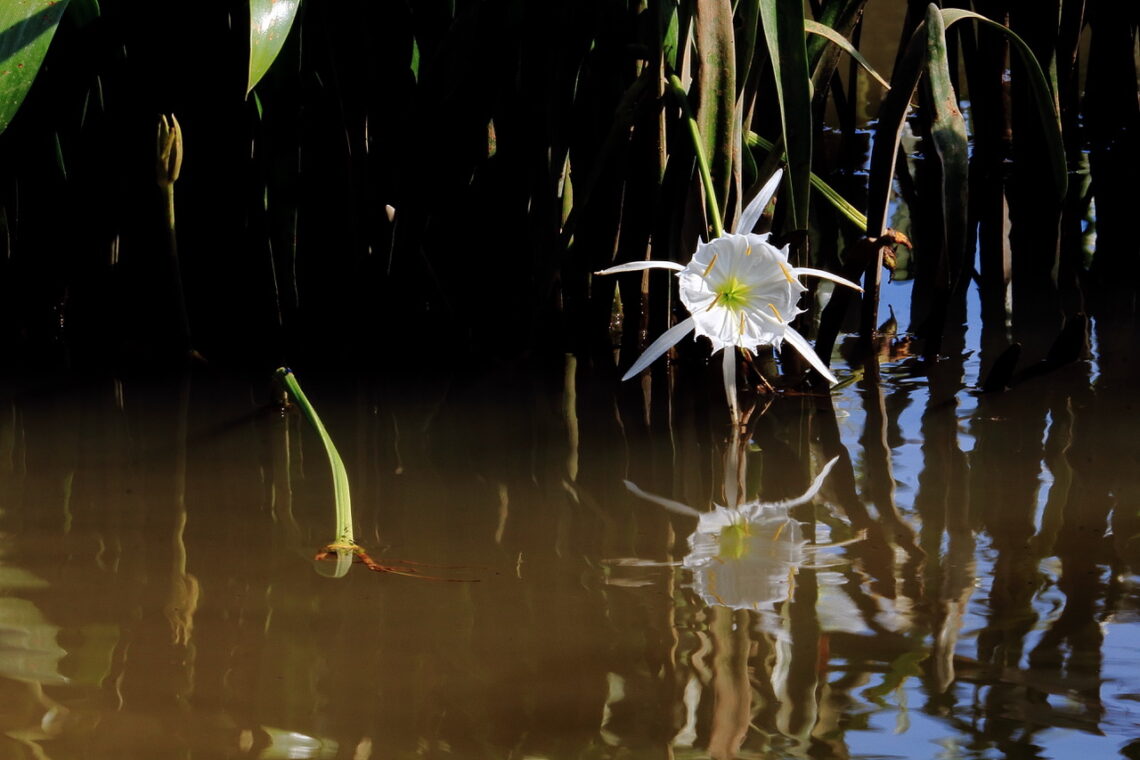
The Shoals Queens, Botanical Royalty
By Tom Poland
Approach with reverence and listen. Faint at first, you’ll hear Earth’s finest white noise. Water whispers, water murmurs as it purls, froths, and foams against bedrock. Milky-white filigrees twist and braid, a sound that begets inner peace as no other sound can.
Peering through trees you see rare botanical royalty. Lustrous green scapes topped by snow-white blooms move to swift water, a bobbing, weaving, mesmerizing dance. Accompanied by the sound of unfettered water you behold South Carolina’s most bedazzling display of nature.
The spectacle unfolds each spring in Georgia and Alabama too. Come May-June, white and green accents adorn rivers and creeks studded by brown rocks.
Seeing rocky shoals spider lilies the first time takes your breath away. “I’ve seen little old ladies weep at their first sighting of this plant,” said Dr. Larry Davenport, the plant’s foremost expert. “The lily has become a symbol of the wild and free-flowing places of Central Alabama.” Davenport’s words from Garden & Gun’s May 2019 issue apply to South Carolina and Georgia as well. With so many shoals beneath lakes, this majestic plant has little habitat left.
If you take your grandmother to see the ballerina-like blooms, take tissues. And understand that you are viewing a species devastated by dams, dropping water quality, and development. It should be federally listed as an endangered species.
Hymenocallis coronaria is exquisite, ephemeral, and periled, in that much of its habitat lies beneath lakes. As the rocky shoals spider lily’s status goes, it’s a national plant of concern.
-Tom Poland
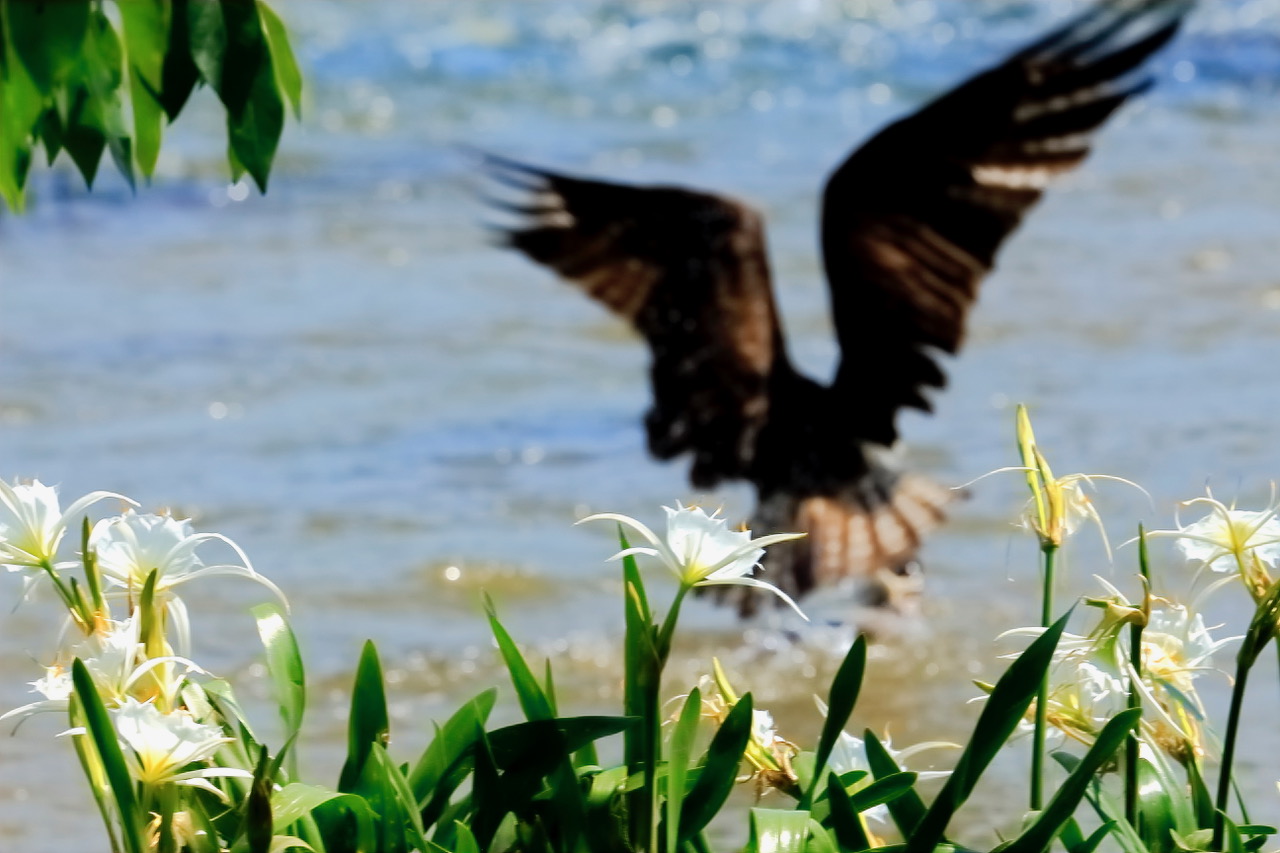
Babylon had hanging gardens and South Carolina has billowing river gardens. You’ll find the world’s largest colony at Landsford Canal State Park in Chester County. One Sunday morning I drove up there. Kayakers darted in and out of majestic clumps, and women oohed and ahed from an observation deck.
See the dancing blooms and enjoy a concert of river song. Green scapes support delicate flowers that bring ballerinas to mind. Dancing flowers upon a stage of rushing water—a performance you’ll not forget.
A magnificent yet difficult to access colony thrives on Stevens Creek in McCormick County. Funding from the South Carolina Conservation Bank and SC Native Plant Society helped Naturaland Trust provide a 13-acre refuge for this stunning colony. Support came from Upper Savannah Land Trust as well.
A survivor from the pre-European landscape, shoals lilies prefer rocky rivers, plummeting elevation, and clean, free-flowing water. Translation, no dams. When you take in the shoals lilies at Stevens Creek and Landsford Canal you glimpse what the Piedmont looked like before big dams rose like massive granite outcroppings.
A bit elusive, other shoals lilies exist in South Carolina. I’m told a colony exists along the Savannah River Bluffs Heritage Preserve near North Augusta. I hear too that Lockhart in Union County has shoals lilies on the Broad River, and I’ve seen places where people have tried to establish colonies. In Ware Shoals several clumps bring beauty to the Saluda River near Irvin Pitts Memorial Park. You can see another man-assisted occurrence in Columbia where the Broad River approaches the Saluda River east of the I-126 Bridge.
Duplicating nature isn’t easy. Dr. Davenport tried. “Over the years, I’ve been involved in several projects to establish or re-establish lily populations, either by seeds or bulbs. So far I’m batting an embarrassing .000.”
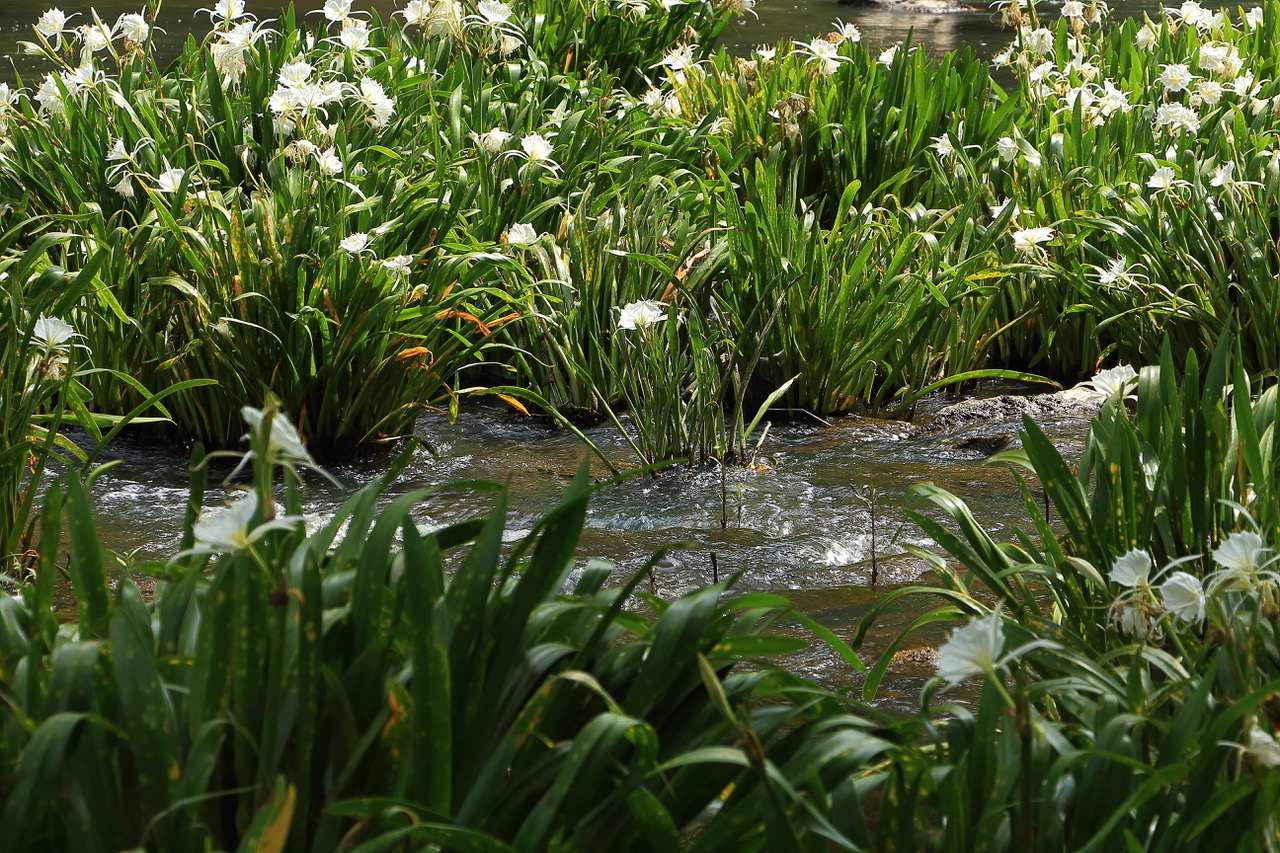
A Lemony-Sugary Fragrance
In 1783 William Bartram, the first botanist to observe this species, described it as the “odoriferous Pancratium fluitans which almost alone possesses the little rocky islets.” (Now known as Hymenocallis coronaria) His sighting was at the cataracts of the Savannah River near Augusta, Georgia. Then as now, the plant loves rocks in swift water. Alas, man’s dams did away with many rocky shoals. And now other troubles have arrived. “Two fairly new problems that ‘our’ (Alabama) lilies suffer from is invasive plants—especially elephant-ears or taro—and scouring due to trees uprooted by stream bank collapse,” said Dr. Davenport.
Each spring I make expeditions to the rocky shoals spider lilies in South Carolina and Georgia for a simple reason: they offer photographers, artists, writers, and nature lovers a dream. You lose track of time and worries in the presence of Hymenocallis coronaria, this aquatic, perennial flowering plant species endemic to the Southeastern United States.
This past spring I visited Stevens Creek three times. The first time, heavy rains had the creek high and heavy with silt. Most lilies hid, submerged. A few days later a good many lilies tossed their beautiful crowns about. My third visit found the creek at normal flow but peak bloom had passed. Even so, beauty aplenty lingered. I waded out and leaned over a pristine bloom to take in its fragrance. A lemony-sugary perfume rose, subtle but heady. To see shoals lilies is to see butterflies and hummingbirds too.
Exquisite and ephemeral, the blooms open at night and last but a day. Long pure white tepals and staminal cup, green bracts, mint green accents, gold stamens, and bright-to-dark green stigma bring that arachnid moniker into play. I prefer crown, even better, diadem. After all, we’re talking botanical royalty here.
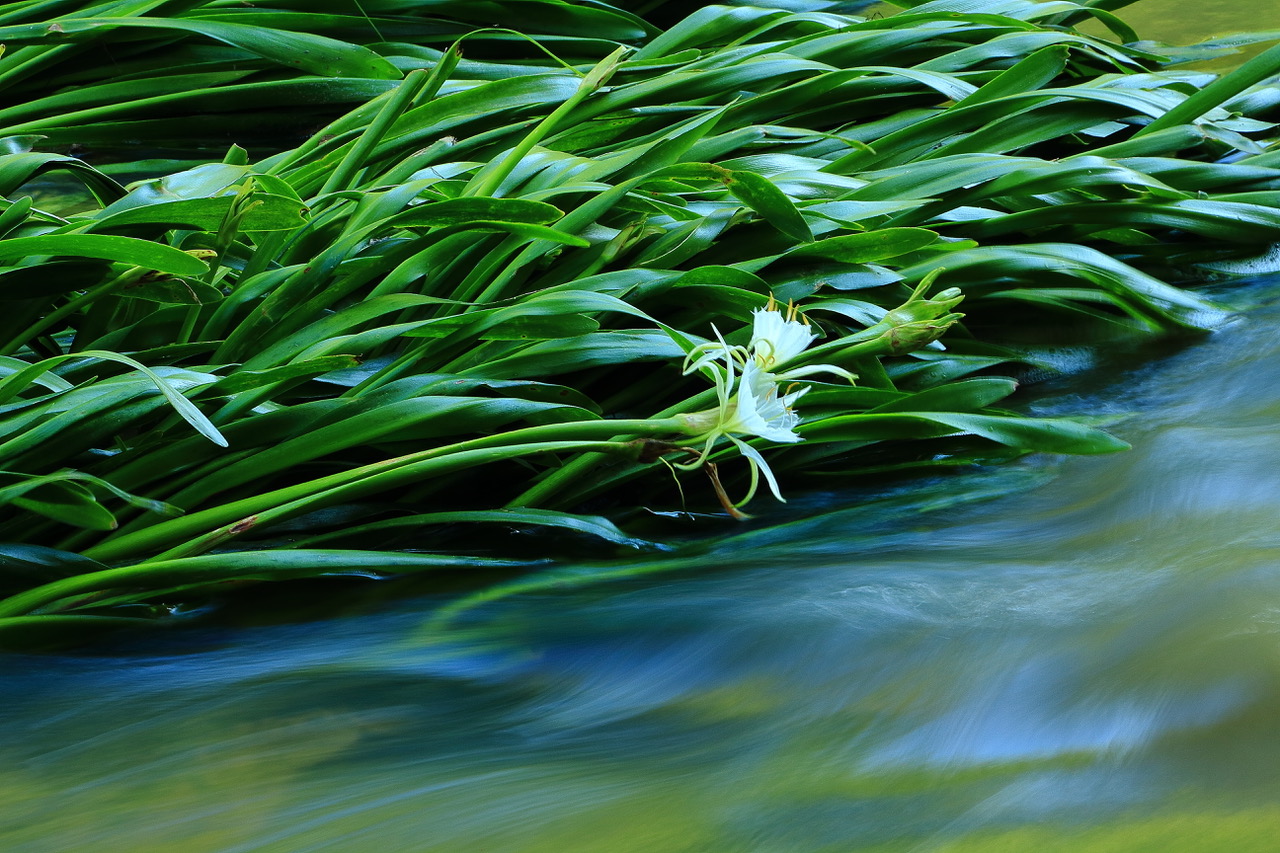
Man’s Tampering Ways
Find shoals lilies and you’ll see man’s attempts to harness water’s power. Uphill from the shoals lilies at Stevens Creek stands an old mill a channel once fed. At Landsford Canal a beautiful stone canal rendered the river commercially navigable from 1820 to 1835.
In Georgia, a splendid colony survives four minutes as the osprey flies from the South Carolina border, and, yes, ospreys haunt the shoals. Long ago men dynamited a channel through its midst so Petersburg boats could get through. That the shoals exist is miraculous. This breathtaking colony beat not one but two dams—Russell and J. Strom Thurmond (Clarks Hill). Maybe you haven’t heard of it but naturalists, botanists, kayakers, and artists have. Writers, too. Anthony Shoals, wild and accessible by land with great difficulty, draws me each spring.
Artist Philip Juras painted Anthony Shoals in oil on canvas and his essay in Bartram’s Living Legacy: Travels and the Nature of the South beautifully describes the setting and its significance. His words apply to Stevens Creek and Landsford Canal
“There is no river scene in the Piedmont of northeast Georgia more stunning than Anthony Shoals on the Broad River. Perhaps there used to be. Perhaps the many great shoals on the Savannah River were just as glorious before they fell silent beneath the waters of the Thurmond, Russell, and Hartwell reservoirs, but I’m not quite old enough to have known any of them. Only the rapids above Augusta, my hometown, still show the beauty of the Savannah before it leaves the Piedmont. But the wildness of the river there is diminished by the new mansions looking down from the bluffs and the dams parceling out the flow from upstream. I think that’s why I love Anthony Shoals so much. This final stretch of the Broad, as it runs through the Broad River Wildlife Management Area, is the only place in the upper Savannah River watershed where the sound of a wild river still rises from such a wide swath of bedrock.”
Juras described the setting at the time of his splendid painting. “On the evening I captured this view, mountain laurel, snowbells, mock orange, Piedmont rhododendron, and fringe tree were in various states of bloom on the steep slopes next to the river. The main show, however, was being staged on the river itself, where one of the few populations of shoals spiderlilies left in the Savannah watershed was catching the light of the western horizon with glorious full blooms.”
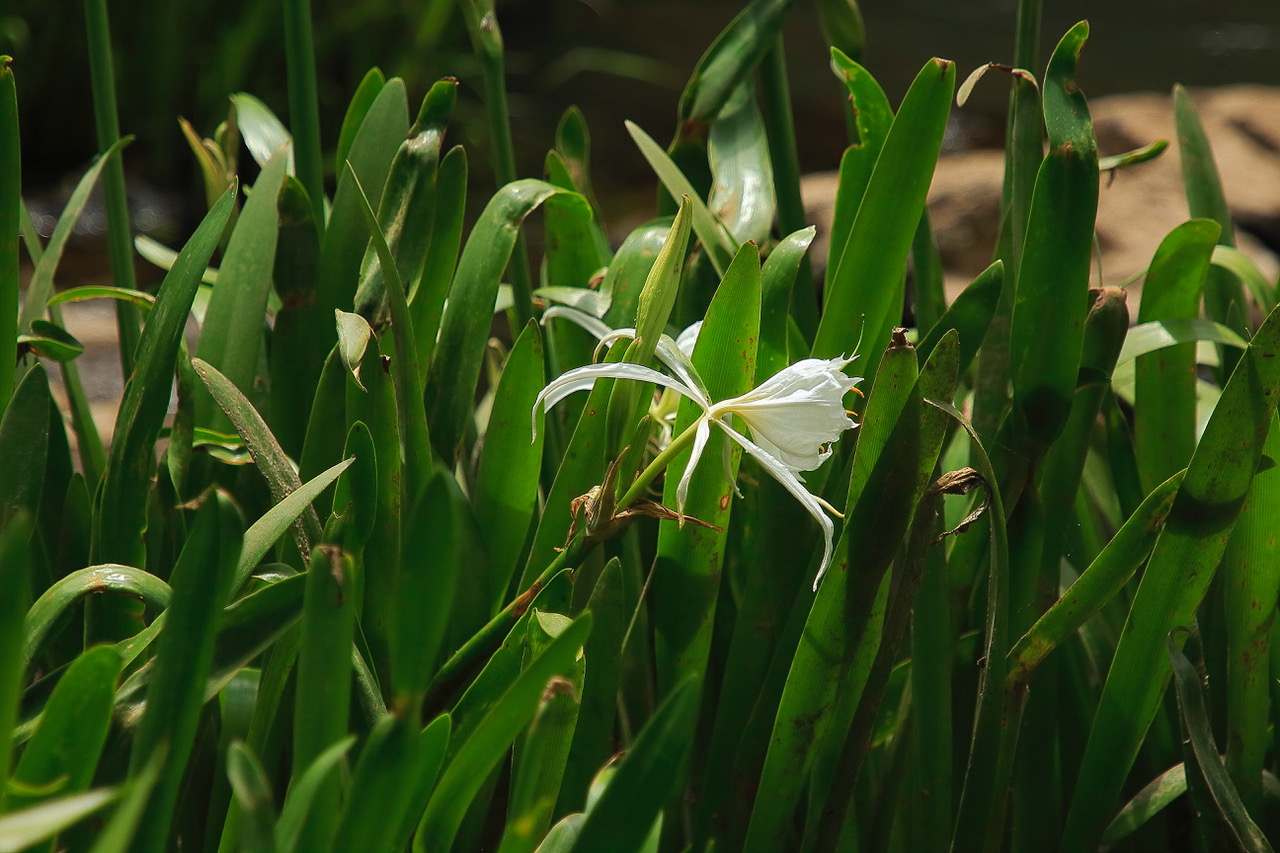
A Lily—To Be or Not to Be
So, is the rocky shoals spider lily a true lily?
No. These cousins of daffodils grow on similar-sounding rivers, the Catawba and Alabama’s Cahaba. Folks in Alabama call it the Cahaba lily; elsewhere it’s the shoal lily. In Georgia, it’s usually called the shoals spider lily. Most botanists and conservationists call it the “rocky shoals spider lily,” a name arising from its preferred habitat: rivers where fast-flowing, oxygen-rich water runs over rocks, i.e. shoals. This stunning perennial grows three feet high in direct sunlight. Flowing water carries its seeds and bulbs away and when they land in a rocky crevice, a colony forms—if conditions are right. Man’s dams did away with many of the right conditions, i.e. rocky shoals.
Bartram saw, as you can, elegant white flowers arcing over dense green scapes, their thick clusters festooning rocks. Each plant sends up one to three scapes with as many as six to nine flowers adorning each scape. (The plant’s beauty lures collectors, another reason it’s in danger.)
Doing my best to follow in Bartram’s steps I explore places where a world exists before dams and electricity changed things. When I find rocky shoals spider lilies, I’ve found such a place. You can too. Late spring, head to Landsford Canal, head to Stevens Creek. Head to daunting Anthony Shoals, if you dare. The flowers won’t last long, so don’t tarry. You’ll come away with memories of a place artist Philip Juras described as a “watershed where the sound of a wild river still rises from such a wide swath of bedrock.” And you’ll never forget the showy, exquisite rocky shoals spider lilies, botanical royalty.
Mark your calendar for an adventure. The flowers are rare and they only bloom a short while. It is, indeed, a transient spectacle.

Tom Poland
writes about the South, its people, culture, and natural features. Poland gives talks throughout Georgia and the Carolinas. Governor Henry McMaster conferred the Order of the Palmetto, South Carolina’s highest civilian order, upon him for his body of work, stating, “His work is exceptional to the state.” A Georgia native and graduate of the University of Georgia, he lives in Columbia, South Carolina.


You May Also Like

Tigers on the Zambezi
July 11, 2022
Haute Horns by Annlyn Barnett
January 14, 2022
